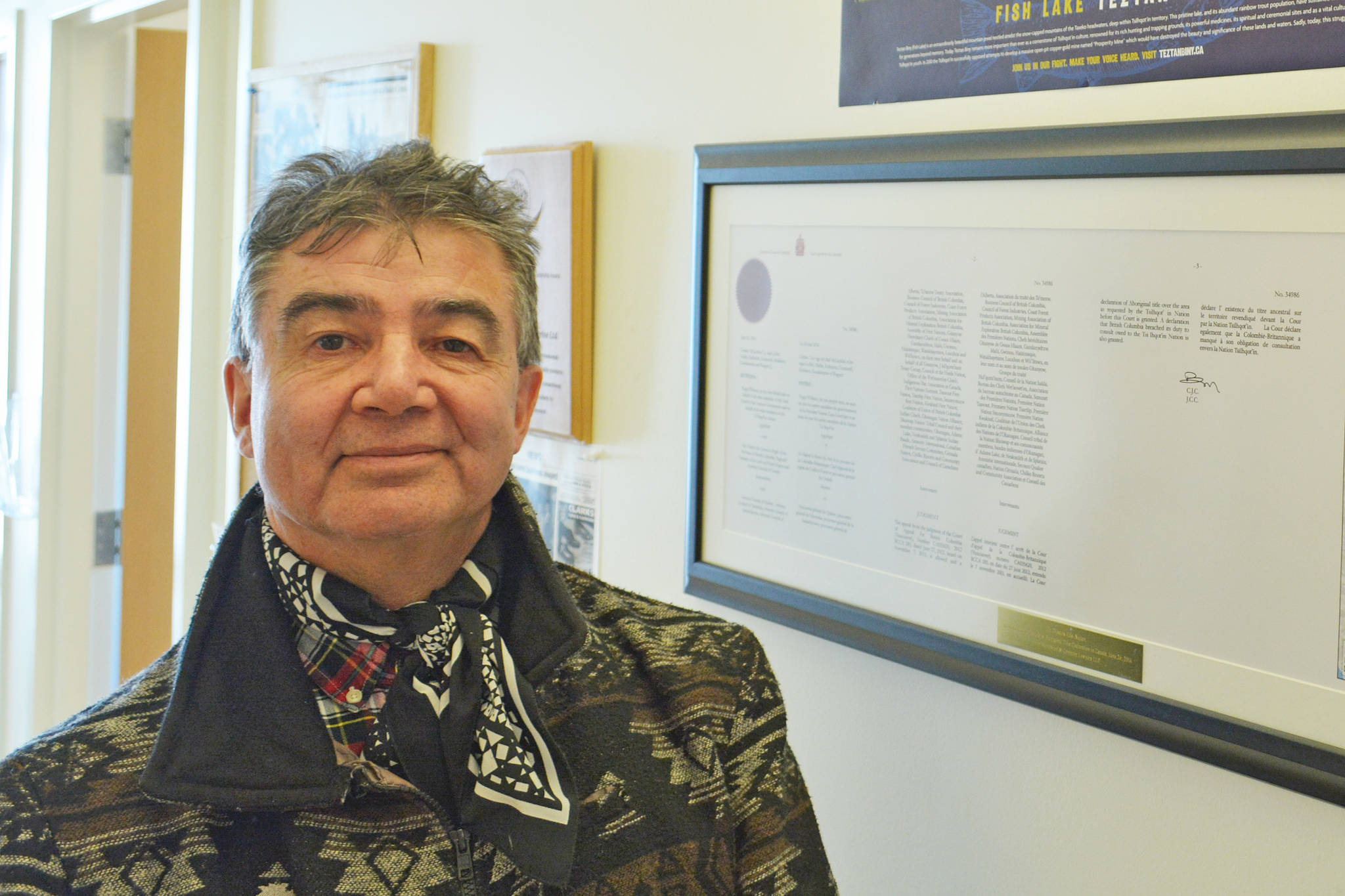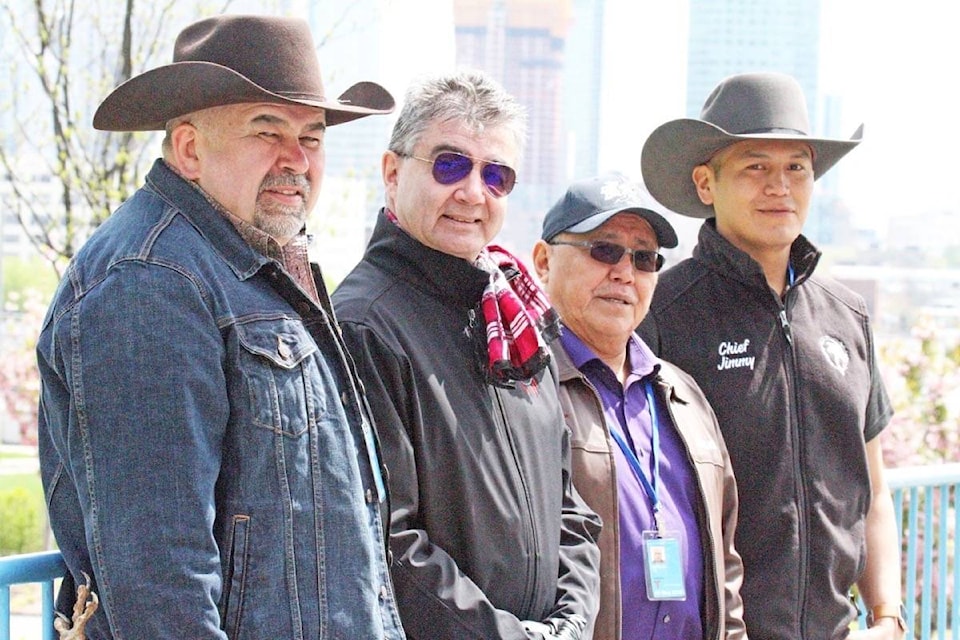It’s a blue sky spring day in the Chilcotin and Chief Francis Laceese’s community of Tl’esqox (Toosey) First Nation is busy with activities.
There’s a friendly traditional cooking competition for all ages underway involving dozens of people and inside the main new health building, counsellors with Nenqayni Wellness Centre Society mobile team are hosting a session for community members.
Read more: First-ever Tsilhqot’in master chef challenge sizzles
Laceese takes a break from his chief duties to check out the activities, something that is second nature.
After all, he was 24 years old when he was first elected to band council and throughout the last 35 years has either been chief, a councillor or band manger, but mostly chief.
He was born in the Quesnel hospital next to where the five Tsilhqot’in warrior chiefs were buried after they were hanged in 1864.
“We grew up on what used to be called Moon Ranch, my dad Donald Laceese was a ranch hand, originally from Anaham, and my mom Rosie Isnardy was from Toosey. They are both gone now.”
His dad would do haying contracts back in the Mackin Creek area in a place called Kinlock Meadow.
School for Laceese was at St. Joseph’s Mission Residential school for about 10 years and from there he attended Williams Lake Secondary and Columneetza for high school.
“I have three sisters, one passed that was a year younger than me a long time ago. One of my sisters works with me and my younger sister lives out in Nemiah.”
While he was a teenager he was attending school and working on a ranch.
Eventually, he was asked to ranch at Toosey so he left school to do that full time.
In 1980s, when he was on band council, Laceese asked David Zirnhelt if he would help his community develop ranching.
“It was before David got into politics,” Laceese said, referring to the fact Zirnhelt later became an MLA.
In a separate interview Zirnhelt said he was living at Big Lake at the time and had completed his master’s degree studying the development of the Cariboo Tribal Council.
“I was offered an opportunity to work in planning and development for the Carrier Chilcotin Tribal Council, which Toosey was part of, and right around that time Toosey wanted to develop their lands but had a water shortage,” he recalled. “They had water rights to develop 400 acres of prime alfalfa growing land.”
Zirnhelt helped them plan an extensive irrigation system for hayfields and range land.
“In the process they built another storage dam and participated with other local non-First Nations ranchers to build other dams. Early on Francis was a leader with an abiding interest in agriculture,” Zirnhelt said.
During the 1990s three separate issues came to the forefront for Laceese’s community.
The Department of National Defence Chilcotin Training Area, logging in Tl’esqox territory, and logging trucks using the only access road that went right through the reserve to Farwell Canyon.
“There were logging trucks coming through 24/7 that killed a few horses and almost ran over some children,” he recalled.
“We said, ‘that’s it,’ and I told one of my workers to block the road with a log.”
When logging trucks showed up they couldn’t get through and the RCMP were called in.
Eventually representatives from the government arrived to negotiate, however, Laceese told them there was nothing to negotiate and that’s when a new road was built.
Additionally, several times community members were arrested for setting up road blocks to the military training area.
“We were charged criminally and went to court in Williams Lake. The RCMP were there as well because they had been involved,” Laceese recalled. “The RCMP had their lawyers and when the judge asked where our lawyers were, I said, “your honour, the reason we don’t have lawyers here today is because we are here to tell the truth.’”
Laceese is proud of the Tsilhqot’in rights and title case.
“There’s been a lot of improvement in a number of ways at the community level and at the nation level,” he said.
The fact the Tsilhqot’in Nation achieved recognition of rights and title in the Supreme Court of Canada decision in 2014, has been a big step historically, he said.
“I believe all nations have title, but they are not recognized. Something had to give because for more than 150 years the government was in denial of our human rights.”
In April 2019, he was part of a Tsilhqot’in Nation delegation at the United Nations Permanent Forum on Indigenous Issues in New York City.
Read more: Tsilhqot’in chiefs travel to New York City to speak on Indigenous struggles at United Nations
“It was quite the experience to be there,” Laceese said. “It’s a two-week forum where First Nations from around the world come and make presentations about their issues.”
A lot of nations who attend do not end up doing presentations, maybe because of timing, but the TNG reps were given two time periods to present because the government of Canada representatives gave up their time slots.
Chief Joe Alphonse spoke and then Laceese.
“We put together a small statement and thanked Canada for giving us their seat. I had my son there and he was able to sing the same song he sang in Ottawa when Prime Minister Trudeau exonerated our war chiefs. We pretty well had a standing ovation after from all the different delegates that were there.”
Laceese felt the Tsilhqot’in presentations gave hope to other Indigenous people at the forum.
“We hosted a side event there and it was packed and our discussions on our rights and title had a lot of interest. We showed them a film that Trevor Mack put together for us. We made a few connections and have had a few invites.”
At the former Riske Creek Elementary School on Stack Valley Road, his community has developed Toosey Old School for trades training and construction under the leadership of Craig Kennedy.
Embracing a “forest-to-frame” concept, using locally-sourced wood from traditional Tsilhqot’in Nen (land) in the National Defence Training Area, First Nations people are employed in harvesting, milling and construction.
“We are negotiating with the government to build housing over the next 10 years and plan to build some houses for our own people. We keep doing a lot of training to build up our people so they will be able to do that.”
Laceese said the six Tsilhqot’in chiefs have met with the Minister of National Defence to discuss the military lands.
“I also met with him myself in Vancouver and said we would like to begin the negotiation process to the extent we want it returned back to us and we want an ordinance for a clean up. They did that over by Tsuu T’ina Nation near Calgary. They had a similar military block — it took the government over 10 years and about $40 million before they handed it back to the nation.”
He’s hopeful they will get some of it back and some compensation, he said, adding now the Tsuu T’ina Nation is doing development on that land.
A proud father and grandfather, he has four children and five grandchildren. When he’s not working for his community, he loves to hunt, fish and spend time with his family.
Life is busy, busy, he added.
“My calendar has whole months filled up because of our negotiations with the federal and provincial governments on our title case. It’s to the point where I have to have an assistant now.”
Laughing he admitted he’s old school and does not do anything on computer.
“I purposely don’t know how to text and at my home I don’t even have phone access.”
news@wltribune.com
Like us on Facebook and follow us on Twitter

